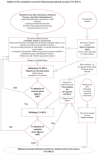Content
About the statistics
Definitions
-
Name and topic
-
Name: Annual national accounts
Topic: National accounts and business cycles
-
Responsible division
-
Division for National Accounts
-
Definitions of the main concepts and variables
-
See Concepts and definitions in national accounts for definitions and explanations of concepts and variables.
Valuation
Valuation is particularly relevant for transactions of goods and services, but also for the general aspect of registration (cf. cash values or accruals values, and other principles for the recording of statistical data). The transactions of variables in the national accounts follow the accruals principle. Thus, taxes on production and subsidies are recorded as accrued values and not as recorded in the government accounts (taxes on production and subsidies in cash values).
In the description of the transaction of goods and services several price concepts are used. Output is valued at basic prices, while the use categories, both intermediate consumption and final use, are valued at purchaser prices, including exports at fob (free on board). Imports are valued at cif (cost-insurance-freight). Basic prices mean that the corresponding taxes on products are deducted and subsidies on products are added to output recorded at producer prices.
The value added of an industry is "valued" at basic prices (calculated as output at basic prices less intermediate consumption at purchaser prices). The total value added of the industries is also "valued" at basic prices.
GDP is "valued" at market prices, which means that taxes on products, including VAT, less subsidies on products are added to the total value added of the industries at basic prices.
-
Standard classifications
-
The accounting system of the Norwegian national accounts is based on the international standards for national accounts, i.e. 2008 SNA and ESA 2010. The accounting system outlines the framework and contents for the production of national accounts statistics. In addition to accounting structure, the accounting system contains a number of groupings or classifications used in the national accounts, of which the most important are described below:
Activity classification
The activity classification used in the national accounts is based on the Norwegian Standard Industrial Classification (SN2007) , which is based on NACE Rev.2 . Several levels of aggregation have been introduced for publication and reporting purposes. See Industries in the Norwegian National Accounts .Classification of non-financial assets and gross fixed capital formation
Non-financial assets are classified by type of aggregates defined in 2008 SNA, such as fixed assets, inventories, research and development, valuables, and non-produced assets, both including tangible assets such as land, subsoil-assets, water resources etc and intangible assets such as patented entities, transferable contracts etc. It classifies the various types of non-financial assets according to the structure of these main items. This classification is more aggregated than the corresponding classification used for gross fixed capital formation by type. Gross fixed capital formation is grouped by main type within building and construction, machinery and equipment and transportation equipment.Product classification
The product classification of the national accounts relates to aggregates of goods and services that are specified in the national accounts. The classification is based on the EU's central product classification CPA - Statistical Classification of Products by Activity in the European Community . The CPA groups products by activities, i.e. it defines characteristic products within each activity and connects them to the activity classification NACE Rev.2Classification of individual consumption by purpose
The classification of individual consumption by purpose is based on the international classification COICOP - Classification of Individual Consumption by Purpose , published by the UN. Consumption expenditure groups in the National AccountsClassification of the functions of government
The classification of the functions of government by purpose apply to all types of general government expenses, such as government final consumption expenditure, gross fixed capital formation, subsidies, property income (i.e. expenses), capital transfers and other transfers for use in government financial accounts and in the national accounts. This classification is based on the international classification COFOG - Classification of the Functions of Government , published by the UN.Classification of the purpose of non-profit institutions serving households (NPISH)
This is a minor purpose classification which applies to expenses of NPISHs. It is based on the international classification COPNI - Classification of the Purposes of the Non-Profit Institutions Serving Households , published by the UN.
The statistics is now published as National accounts.
Additional information
Special tables for experienced users:

